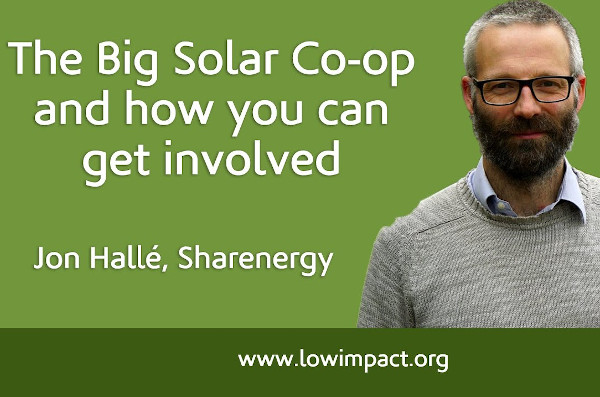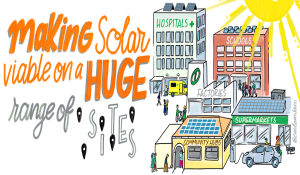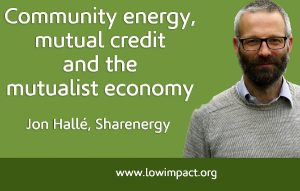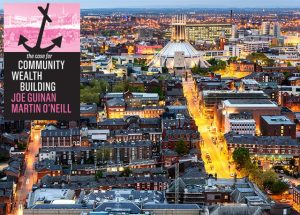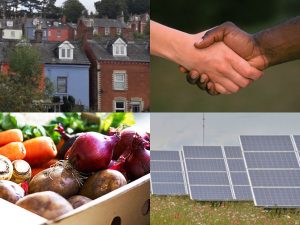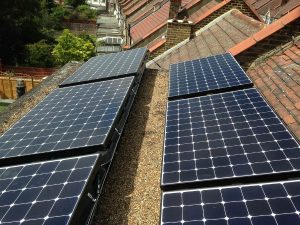Today I’m speaking with Jon Hallé. We go back about 20 years. You ran courses on how to make biodiesel for Lowimpact, back in the early noughties, and you authored a book for us about making biodiesel, that sold about 15k copies in the first year. It caught the zeitgeist then, but of course diesel vehicles have had their day now. Then you started Sharenergy, setting up community energy schemes around the country. Now you’ve founded the Big Solar Co-op.
It’s something we’re incubating withing the Sharenergy co-op. It will be an independent co-op.
[Parts two and three of this interview]
Before we go into the nuts and bolts of what it is – what’s your motivation for doing it? What’s the problem you’re trying to solve with the Big Solar Co-op?
The main problem is the climate crisis. But on a smaller scale, it’s about how members of the public can get involved with projects to help combat the climate crisis – where the public can be involved in actually owning and running tangible renewable energy projects. Some of this is solar panels on roofs, some is empowerment of people – their ability to change the world, and their understanding of renewables. Also jobs for people, and support for good organisations, plus opportunities for people to invest their money in things they believe in as well.
So what is the Big Solar Co-op?
I’ve been working in community energy for almost 20 years, and the model is very small co-ops, locally based. It’s a great model, and we’ve been involved in setting up over 100 of these across the UK. That’s been really successful, people love them, and it reaches out beyond the usual political divide. Plenty of these have been set up by people who are not your classic greenies.
What technologies?
All renewables – mostly solar; plenty of wind co-ops; hydro co-ops; and a few heat co-ops as well. It’s become very hard to set up these small co-ops, largely due to the withdrawal of support for renewable energy from the government, particularly for community-scale projects.
Is that why you’ve developed the Big Solar Co-op idea?
Yes. The government’s feed-in tariff scheme caused a boom in community schemes. Before the feed-in tariff there were only a few community energy co-ops. When the feed-in tariff came in, suddenly I was talking with people in church halls and pubs about ideas for renewable energy projects all over the UK. We knew the subsidy was going to end, so we wondered what to do. Schemes were selling their electricity to the grid for about 5p per unit, and they were getting around 5p per unit from the feed-in tariff as well. So they were losing half their income. We weren’t just going to give up. With solar schemes, as well as selling to the grid, they were selling the electricity generated to the owners of the roofs that the panels were on – for less than grid price. So maybe they were getting 10-11p per unit from the roof owners, rather than just 5p from the grid. But that approach is risky – for example the business under the roof might go bust. So the way to reduce the risk is to grow in scale – to put a lot of solar on a lot of roofs.
So you approach businesses or public buildings with big roofs and ask if they’d like solar panels on their roof. And the attraction for them is cheap electricity?
It’s more than that. A lot of businesses and organisations want to help with the climate crisis, and don’t know what they can do, and don’t have much spare cash – especially for something with a long payback time. We tell them that we have a solution for them. So we have interest from people who we can’t help save much money – but having said that, we’ve worked with organisations that, over the life of the system, will save them over a million pounds.
And it’s brownie points isn’t it – you might pick up some extra customers by doing this sort of thing?
Yes, and decisions are coming from upstream about environmental considerations. It all boils down to getting brownie points for the company.
There’s something else I want to say about volunteers / participation for the public. If your co-op is very small, you’ll be spending a lot of time just setting up and running the organisation, and problem-solving.
I guess it’s re-inventing the wheel for each community co-op?
Yes, and there are some great things about that. But why not have a situation where there’s a national co-op with local groups. People feel as though they’re part of a movement (and they are), and they’re able to share resources better. And instead of having an organisation in each town, with its own admin, accounts, AGM etc, you just get one set of accounts, one AGM, rather than everybody having to do it. That frees up time for local people to go out and find new sites and get solar installed. Although it does mean that the groups are not 100% locally owned.
When did you launch, and what’s happened so far?
We started the project 2 years ago. We got some funding from some charitable trusts, which we’ve never done before with Sharenergy. But we knew we were going to do things differently, and we wouldn’t make money for a while, so we needed to get some funding in. Funding has allowed us to employ people for 2 years. We’ve got a year left of funding, and then we have to really start building things and getting income from them. We want to test the idea, get something robust, before going big with it. We think the potential is huge. One thing we’re doing that we haven’t done before is training.
What kind of people are you looking for, and how can they get involved?
Well, every time I think something has to be done by a paid member of staff, I wonder whether it’s true – could it be done by a volunteer who really care about the subject? And usually, it can. Large parts of the community energy movement have already been built in exactly that way. People can get involved in solar design. We’ve been running webinars that anyone can join. We’ve been doing it regularly, and you can look at the recordings. We use a piece of software called Open Solar, that you can get access to for free. You can look at roofs and work out how many panels could go on them. If somebody spots a site that they think will be good for solar, they can report it on our site, and that will get taken up by one of our trained volunteer solar designers, and they’ll design a first pass of a solar array on the roof – or they might decide that the roof is not suitable.
That’s very important isn’t it?
Yes, we don’t want to waste people’s time or engage in magical thinking. We’re too far into the crisis for that. If something’s not viable – don’t bother. There are enough roofs in the UK. So – we’re also training people to approach people who potentially have good roofs for solar.
It must be a good feeling to walk through your town, and to see a roof covered in solar, and to think ‘I’m responsible for that’.
Yes. It sustains me too. I remember when we were involved with biodiesel, occasionally I’d be walking along, and I’d recognise a biodiesel vehicle going past due to the smell (a bit like doughnuts frying). I’d wonder if they came on one of our courses, or read the book. I was then involved with putting up big wind turbines that had the same effect – and now solar. Solar is designed to last for a long time. They hardly degrade at all over 25 years.
Yes – we have panels on our roof. They’re expected to deliver electricity for 25 years, and because we got in before the feed-in tariff, we get that payment for 25 years too.
Yes, it’s great. The other thing is scale and whether community ownership is the right way. There are large commercial solar arrays, and so there’s a counter argument that if capitalism can deliver renewable energy and decarbonisation, why would we do it? We’re maybe too late in the crisis to be having this fight. Big Solar Co-op will be putting solar on roofs that the corporates are not interested in, because they can’t make enough money out of it.
There’s another side of the argument for me – it’s the decentralisation of wealth and power. Wealth is becoming so concentrated that it has massive implications for democracy, which has implications for what we can do at all.
It depends where we believe we’re at with the climate crisis. I think it’s a big mistake to say that we have to do it via the capitalist model because we don’t have time to do it any other way. But I might feel differently about this than when we first started working together, when I thought that the route to decarbonisation had to go through decentralisation and mutualisation. But I think now we’re so close to climate deadlines that we can’t do it without also harnessing the power of raw capital.
For sure. If the big energy companies want to go renewable – yay! But I’m still much more interested in the decentralisation of wealth and power generally, not just in the energy sector, but in every sector.
Of course. There are so many aspects of co-operatives that are well-suited to an ecological mindset. They’re stable (ie they don’t have to constantly grow) institutions that bake in democracy. And if you’re going to have institutions that are sustainable, ecologically responsive and responsible, then that kind of scale and that means of control is important. And this sector is unfulfilled. I have colleagues who are talking to all kinds of people – in outdoor centres, factories, universities. They all say that they’d love solar, but there’s no way they’re investing in it themselves right now.
So back to the Big Solar Co-op – I guess you’re looking for people who are concerned, involved in their community, and quite entrepreneurial?
There’s a range of different skills required. For example, at the moment we don’t have anyone to ring around all the groups once a month and put together a news story for the website. That would be brilliant. Also people who know their locality and are happy to talk with people. There are roles that are not entrepreneurial or technical, but it’s hugely valuable. We have lots of different roles, and you don’t have to dedicate your whole life to it. We run training sessions to teach people exactly what they need to know. And there’s mutual support and knowledge sharing.
So I guess people just contact you if they’re interested?
Go to BigSolar.coop. There’s a section on volunteering, and people can register as a volunteer. We’ll onboard you and you can attend webinars etc.
And what’s the ambition with Big Solar?
One ambition is to kick-start community solar again – to give it a shot in the arm. There are community energy schemes that have weathered the end of subsidies and continue to work in their local area. There are great people like Brighton Energy Co-op, Bristol Energy Co-op, Low-Carbon Hub in Oxford, Repowering London, Egni Co-op in Wales. Fantastic organisations. You’ll notice that not many of those are north of the M4 – but there’s a big country out there. There’s very little community energy in the Midlands and the North. Can we take the model and make it work there? So that’s another ambition. Another is to install 100 MW on roofs by 2025. So that’s all pretty ambitious.
So anyone out there who wants to see more solar installed in their town, and would like to work with Jon – give him a shout through bigsolar.coop.
Yes – but more importantly than working with me – working with other people trying to do the same thing in their areas.
Highlights
- Community energy schemes were selling their electricity to the grid for about 5p per unit, and they were getting around 5p per unit from the feed-in tariff as well. So when the feed-in tariff ended, they lost half their income.
- With solar schemes, as well as selling to the grid, they were selling the electricity generated to the owners of the roofs that the panels were on – for less than grid price. So maybe they were getting 10-11p per unit from the roof owners, rather than just 5p from the grid. But that approach is risky – for example the business under the roof might go bust. So the way to reduce the risk is to grow in scale – to put a lot of solar on a lot of roofs.
- We’ve worked with organisations that, over the life of the system, will save them over a million pounds.
- Go to BigSolar.coop. There’s a section on volunteering, and people can register as a volunteer. We’ll onboard you and you can attend webinars etc.

